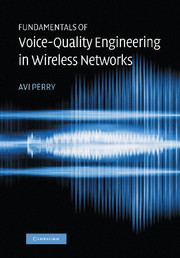Book contents
- Frontmatter
- Contents
- Preface
- List of abbreviations
- Introduction
- Part I Voice-quality foundations
- Part II Applications
- Part III Wireless architectures
- Part IV A network operator's guide for selecting, appraising, and testing a VQS
- Part V Managing the network
- Part VI Afterthoughts and some fresh ideas
- 13 Tracer probe
- 14 My sound
- 15 A procedure for evaluating and contrasting new wireless codecs' performance with and without VQS
- 16 The theory of sleep
- Part VII Recordings
- Glossary of common voice-quality systems terminology
- Brief summary of echo cancelation and VQS major standards
- Brief summary of key voice-quality assessment standards
- Bibliography
- Index
15 - A procedure for evaluating and contrasting new wireless codecs' performance with and without VQS
Published online by Cambridge University Press: 24 May 2010
- Frontmatter
- Contents
- Preface
- List of abbreviations
- Introduction
- Part I Voice-quality foundations
- Part II Applications
- Part III Wireless architectures
- Part IV A network operator's guide for selecting, appraising, and testing a VQS
- Part V Managing the network
- Part VI Afterthoughts and some fresh ideas
- 13 Tracer probe
- 14 My sound
- 15 A procedure for evaluating and contrasting new wireless codecs' performance with and without VQS
- 16 The theory of sleep
- Part VII Recordings
- Glossary of common voice-quality systems terminology
- Brief summary of echo cancelation and VQS major standards
- Brief summary of key voice-quality assessment standards
- Bibliography
- Index
Summary
Introduction
In Chapters 2 and 9, I discussed studies that illustrate a considerable weakness of the GSM half-rate codec in the face of noise. I also brought to light study results showing that an effective NR algorithm may be able to remedy some of the HR weakness and lift the voice-quality performance back to par for signals with a relatively poor SNR (see Figure 9.13).
As new wireless codecs are introduced at the market place, many service providers wonder whether VQ systems are effective in enhancing quality, as higher compression ratios are used in an attempt to reduce spectrum requirements and augment air capacity.
In this chapter, I introduce a procedure for testing the hypothesis that a new codec with a higher compression ratio offers an inferior (or equivalent) voice-quality performance in comparison to an existing codec, specifically under noisy conditions.
If the hypothesis proves to be true, then there is a need to test the hypothesis that VQS can lift the performance level of the new codec to a close proximity (or beyond) of the existing codec (under noisy conditions and without VQS).
Procedure
The procedure outlined here involves two phases.
Phase 1 (see Figure 15.1)
(1) Send pre-recorded speech signals from point B without noise. Capture and record speech signals (pre-recorded) at point A.
(2) Send pre-recorded speech signals from point E with noise. Capture and record speech signals (pre-recorded) at point D.
(3) Send pre-recorded speech signals from point B without noise. Capture and record speech signals (pre-recorded) at point A while sending speech signals from point A (double talk).
[…]
- Type
- Chapter
- Information
- Fundamentals of Voice-Quality Engineering in Wireless Networks , pp. 299 - 300Publisher: Cambridge University PressPrint publication year: 2006



